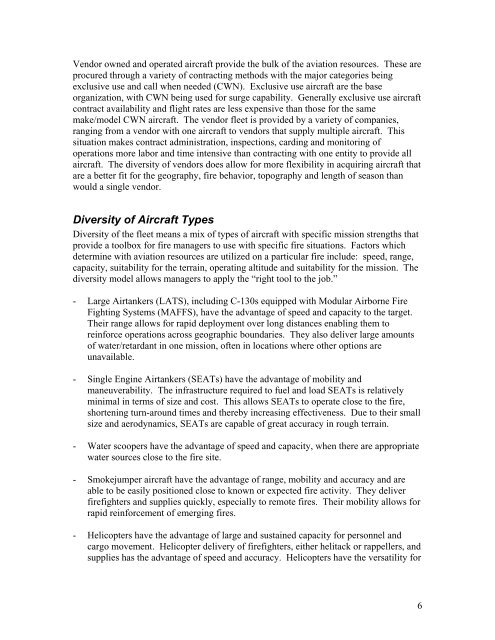Interagency Aviation Strategy - July 2008 - National Wildfire ...
Interagency Aviation Strategy - July 2008 - National Wildfire ...
Interagency Aviation Strategy - July 2008 - National Wildfire ...
You also want an ePaper? Increase the reach of your titles
YUMPU automatically turns print PDFs into web optimized ePapers that Google loves.
Vendor owned and operated aircraft provide the bulk of the aviation resources. These are<br />
procured through a variety of contracting methods with the major categories being<br />
exclusive use and call when needed (CWN). Exclusive use aircraft are the base<br />
organization, with CWN being used for surge capability. Generally exclusive use aircraft<br />
contract availability and flight rates are less expensive than those for the same<br />
make/model CWN aircraft. The vendor fleet is provided by a variety of companies,<br />
ranging from a vendor with one aircraft to vendors that supply multiple aircraft. This<br />
situation makes contract administration, inspections, carding and monitoring of<br />
operations more labor and time intensive than contracting with one entity to provide all<br />
aircraft. The diversity of vendors does allow for more flexibility in acquiring aircraft that<br />
are a better fit for the geography, fire behavior, topography and length of season than<br />
would a single vendor.<br />
Diversity of Aircraft Types<br />
Diversity of the fleet means a mix of types of aircraft with specific mission strengths that<br />
provide a toolbox for fire managers to use with specific fire situations. Factors which<br />
determine with aviation resources are utilized on a particular fire include: speed, range,<br />
capacity, suitability for the terrain, operating altitude and suitability for the mission. The<br />
diversity model allows managers to apply the “right tool to the job.”<br />
- Large Airtankers (LATS), including C-130s equipped with Modular Airborne Fire<br />
Fighting Systems (MAFFS), have the advantage of speed and capacity to the target.<br />
Their range allows for rapid deployment over long distances enabling them to<br />
reinforce operations across geographic boundaries. They also deliver large amounts<br />
of water/retardant in one mission, often in locations where other options are<br />
unavailable.<br />
- Single Engine Airtankers (SEATs) have the advantage of mobility and<br />
maneuverability. The infrastructure required to fuel and load SEATs is relatively<br />
minimal in terms of size and cost. This allows SEATs to operate close to the fire,<br />
shortening turn-around times and thereby increasing effectiveness. Due to their small<br />
size and aerodynamics, SEATs are capable of great accuracy in rough terrain.<br />
- Water scoopers have the advantage of speed and capacity, when there are appropriate<br />
water sources close to the fire site.<br />
- Smokejumper aircraft have the advantage of range, mobility and accuracy and are<br />
able to be easily positioned close to known or expected fire activity. They deliver<br />
firefighters and supplies quickly, especially to remote fires. Their mobility allows for<br />
rapid reinforcement of emerging fires.<br />
- Helicopters have the advantage of large and sustained capacity for personnel and<br />
cargo movement. Helicopter delivery of firefighters, either helitack or rappellers, and<br />
supplies has the advantage of speed and accuracy. Helicopters have the versatility for<br />
6
















